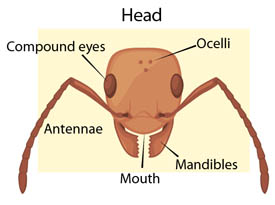Yes, that's correct! Most ants have a head with three simple eyes, called ocelli, located on the top of their head. These eyes are typically smaller than their compound eyes and are used to detect the intensity and direction of light.
Ocelli are not capable of forming detailed images like compound eyes, but they can distinguish between different levels of light and polarization. This allows ants to navigate and orient themselves, particularly during foraging activities when they need to locate food sources and find their way back to the nest.
Some ants also use their ocelli to sense changes in light levels caused by passing clouds, which helps them to maintain their course when traveling long distances. Overall, while their ocelli are not as complex as their compound eyes, they play an important role in helping ants navigate and survive in their environment.
Ants are fascinating creatures that have evolved to survive in a wide variety of environments. One of the most interesting features of ants is their unique head structure, which includes three small, simple eyes on the top of the head. These eyes are specialized to detect light level and polarization, allowing ants to navigate and communicate in a variety of conditions. In this blog, we will explore this fascinating aspect of ant anatomy by asking some key questions.
What are the three small eyes on the top of an ant's head called? The three small eyes on the top of an ant's head are called ocelli. These eyes are simple, single-lens structures that are distinct from the compound eyes found on the sides of the ant's head.
What is the function of the ocelli in ants? The ocelli in ants are specialized to detect the level and polarization of light. This allows ants to navigate and orient themselves in their environment, even when the sun is not visible. The ocelli are particularly useful for ants that live in subterranean environments or in dense forests, where visibility may be limited.
How do the ocelli differ from the compound eyes of ants? Unlike the compound eyes, which are made up of many individual lenses and are primarily used for detecting movement and color, the ocelli are single-lens structures that are specialized for detecting light level and polarization. The ocelli are also located on the top of the ant's head, while the compound eyes are found on the sides.
How do ants use the information from their ocelli to navigate and communicate? Ants use the information from their ocelli to determine the direction and intensity of light. This allows them to navigate in a straight line, even in low-light conditions. Ants also use the polarization information from their ocelli to communicate with each other. For example, some species of ants use polarized light to signal the location of food sources or to communicate the location of their nest.
Are all ants equipped with ocelli? Not all ants have ocelli, but they are common in many species. The presence of ocelli in ants is believed to have evolved as a way to adapt to a variety of environments, particularly those with limited visibility. Some species of ants, such as army ants and leafcutter ants, have greatly reduced or absent ocelli, likely because they rely primarily on their compound eyes for navigation and communication.
In conclusion, the three small eyes on the top of an ant's head, known as ocelli, are a fascinating example of how ants have evolved to survive in a variety of environments. By detecting light level and polarization, ants are able to navigate and communicate with each other in conditions where visibility may be limited. Understanding the unique anatomy of ants can give us greater insight into the complexity and adaptability of these incredible creatures.





No comments:
Post a Comment